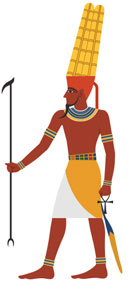Amun | King of the Egyptian Gods
Among all the multitude of Egyptian deities, the god Amun was considered to be the king of the gods, a supreme creator-god. He was the ancient Egyptian god of fertility and life. While most Egyptian gods were 'born' at various points in the history of the Egyptian nation and many floated in and out of popularity, Amun appears to have been present in the mythology and culture of the Egyptian people almost from the very inception of this complex and mysterious nation.
Amun had many names and served several roles in Egyptian mythology and Egyptians often worshiped Amun’s family along with him. Depictions of Amun are found throughout Egypt as are his legends.

© Mary Harrsch - Head of Amun Statue
Names and Titles
Amun was given the title “King of the Gods” of Upper Egypt.
Scholars discovered several different spellings of the name Amun in Egyptian literature. Some of the different spellings are Am, Amen, Amon, Amoun, Ammon and Hammon.
Other countries equated Amun with their own deities:
- Egyptians equated him with the god Min.
- The Greeks equated Amun with Zeus.
- The Romans equated him with Jupiter.
Amun-Ra
Over time, the Egyptians combined Amun with Ra to form Amun-Ra. Alternate spellings of this name include Amen-Ra, Amonra, Amon-Ra, Amon-Re, Amun-Re and Ammon-Ra. Egyptians referred to Amun-Ra as “one one” and “no second” because they considered him the supreme god.
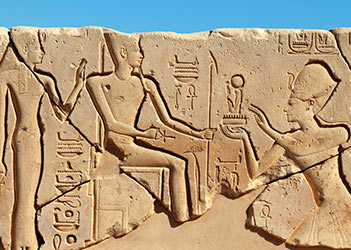
Pharaoh Seti I, offering to Amun and Mut
Roles
- Amun’s first role was as the patron saint of the ancient Egyptian city Thebes, where the ruling pharaoh and his royal family resided. Here he became joined with the sun god Ra and the two became known as the Egypt god Amun-Ra.
- Amun-Ra was the king of the Upper Egyptian gods and one of the most important gods in Egypt, second only to Osiris.
- Egyptians gave Amun-Ra the role of a creative power responsible for all life on earth, in heaven and in the Tuat (underworld).
- Amun was also the father of the pharaoh.
Family
Amun was part of the Thebean triad along with Mut and Khonsu (a triad was a group of three gods including a mother, a father and a child).
- Wife (as Amun): Amunet, a mother-goddess.
- Wife (as Amun-Ra): Mut, goddess of Thebes, female counterpart of Amun-Ra.
- Son: Khonsu, moon god of regeneration and healing
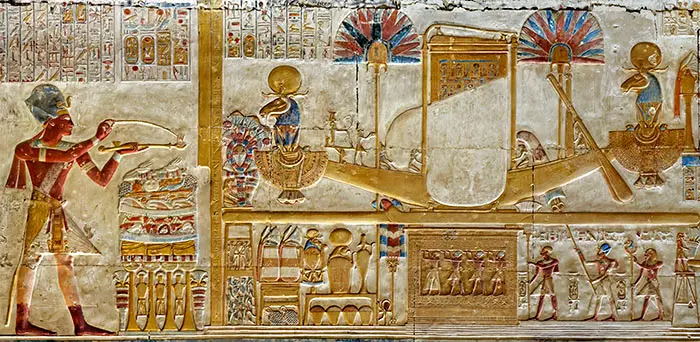
©Kairoinfo4u - The sacred boats of Amun-Ra, Mut and Khonsu
Worship
The history of the development of Amun’s worship is fascinating. He started as a deity worshiped only in Thebes. After the pharaohs moved their capital to Thebes, Amun became a major god. During the Eighteenth Dynasty, he assimilated with Ra and grew in importance.
Many of the Eighteenth Dynasty kings commissioned frescos showing Amun-Ra fathering them. This was also the way rulers whose legitimacy was in doubt proved their right to rule. When Hatshepsut began ruling for her stepson, she commissioned murals showing Amun-Ra fathering her. She used these murals to legitimize her kingship and remain pharaoh until her death.
As the Eighteenth Dynasty progressed, Amun-Ra’s cult grew in wealth and power. Soon, the cult rivaled the pharaoh in power and prestige. This fact contributed to Akhenaten’s decision to declare Aten the only god in Egypt. He moved the capitol to a new city but as soon as he died, Amun-Ra’s priests regained their power. Thebes became the capitol again and the cult of Amun-Ra continued to gain power.
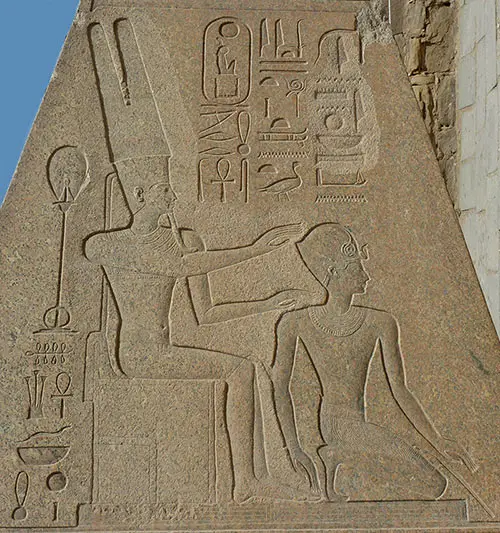
© Hannah Pethen - Hatshepsut knealing before Amun
Cult
Worship of Amun was widespread and the pharaohs’ awarded the cult with land a percentage of the booty from conquests. One of the important positions in the cult was the “god’s wife of Amun” and the queen or queen-mother often fimagecentered this role. These women gained power and depictions show them making offerings to gods.
Two festivals at Thebes involved the images of Amun and other deities traveling to other places:
- During the Beautiful Feast of the Valley, images of the Thebean Triad were taken out of Karnak. They traveled on a boat, across the Nile, to visit the mortuary temples on the west bank.
- At the celebration of the Opet Festival, Amun traveled from the Great Temple at Karnak to the temple at Luxor. This festival celebrated the sacred marriage between the god (Pharaoh) and the god’s wife (the queen).
Temples
Temples dedicated to Amun were built throughout Egypt and Ramses II built or rebuilt several of them. Three of these temples are those at Deir el-Medina, Luxor and Karnak:
- Deir el-Medina is located on the western bank of the Nile across from Thebes and near the Valley of the Kings. Ramses II built this temple and two dedicated to the other members of the Thebean Triad.
- Amun’s temple at Luxor was first built around 1500 BC and has been an active religious site up to the present day. People worshiped a unique version of Amun, named Amenemope (Amun of Opet). Two names for the Luxor Temple are the “Place of Seclusion” or the Southern Opet. This temple was in the heart of ancient Thebes and a processional road connected it to Karnak.
- The temple complex at Karnak is the largest temple complex built by humans and the Great Temple of Amun is its crown jewel. Generations of pharaoh’s added to or rebuilt sections of this temple. Criosphinxes (sphinxes with ram heads) line one of the processional ways. Several courts, obelisks, and pylons, carved with hieroglyphics, are part of this temple. Several temples are part of this complex including one dedicated to Aten. Akhenaten built it during the first five years of his reign, before he moved the capital to Amarna.
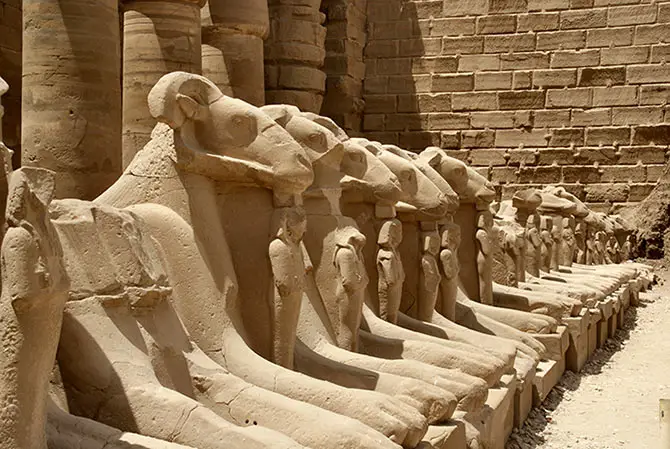
© Nick Dawson - Criosphinx statues at the temple of Amun at Karnak
Symbols
Egyptian artwork associates several symbols with Amun:
- The ram (criosphinx: a sphinx with a ram head).
- The goose
- At times, Amun's frescos show him as an ape or a lion.
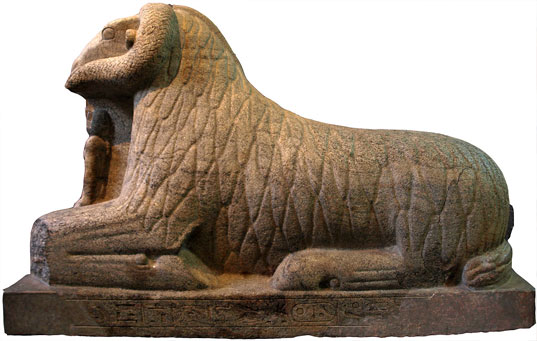
Depictions
Images and statues of Amun usually show him as a man with a blue or black skin.
- He wears a double-plumed headdress and the plumes have alternating colors of either red and green or red and blue.
- Amun wears several pieces of jewelry including a broad collar or necklace, bracelets and armlets.
- His clothing is either a kilt or a tunic with decorated shoulder straps.
- Amun holds an ankh in his right hand and a scepter in his left hand and sometimes a bull’s tail hangs from his tunic.
Amun is also depicted with various animal heads. On occasion, he has a hawk’s head with a sun disc encircled by a serpent on top. Other depictions show Amun with a ram’s head.
Depictions of Amun with his wife Amunet show him with:
- An uraeus (upright form of an Egyptian cobra) head and Amunet with a cat head,
- or Amun with a frog head and Amunet with an uraeus head.
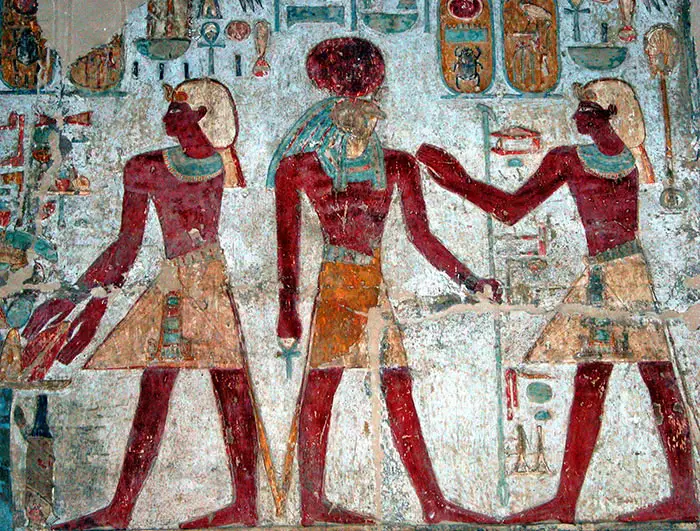
© Dennis Jarvis - Amun-Ra (center) in the temple of Amada
Legends
Amun was a creator god and a force that created life. Instead of featuring in a story myth, many writings about him tell how he helped people gain a victory or solve a problem. Other inscriptions tell of oracles Amun gave to petitioners. His statue would move (hidden priests manipulated it) to answer a question.
Important Facts
- Amun was a creator god worshiped through Egypt.
- Pharaohs were the ‘son of Amun.’
- His cult gained enough power and wealth to threaten the pharaoh.
- Women who were the “god’s wife of Amun” held important places in the cult.
- Some pharaohs used Amun to legitimize their reigns.
- Thebes was the center of his worship.
- Some of Amun’s grandest temples were in Thebes.

